General information about the computer system. How to view basic information about your pc
Surely today any more or less prepared user can easily name the parameters of his computer or information about the system, including the installed "operating system", the type and frequency of the processor, the volume random access memory, disk, etc. But not many people know that this is just, so to speak, the tip of the iceberg. And if you need to know the mode of the DMA channel? What to do then? Now let's talk about how to find out all the parameters in detail.
General information about the system
Many users, of course, may be indignant, they say, why are the parameters caused by a right click on the computer icon bad, where you can view basic information on your terminal or laptop?
The answer lies in the question itself. The information presented in this section is very superficial and does not give a complete picture of the configuration.
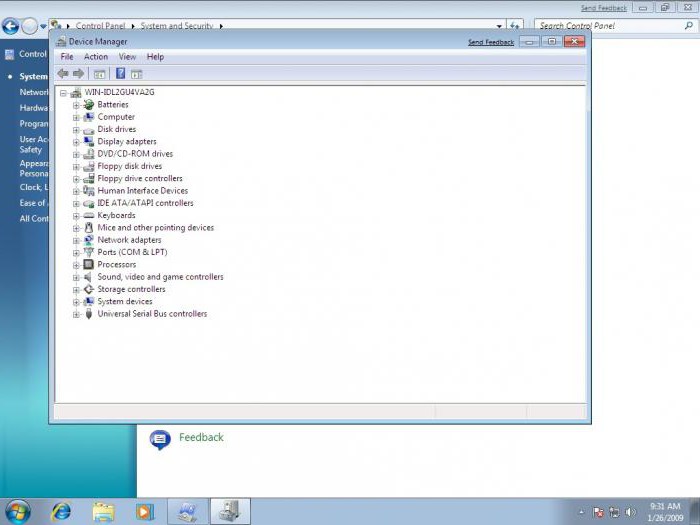
The same goes for the standard "Device Manager". Of course, in it you can see all the "hardware" or virtual components available in the system, even if disabled in the BIOS or those in which there are problems or conflicts. However, in some cases, in order to identify the causes of failures and troubleshoot emerging problems, you need to have more complete information about both the hardware and the software environment.
System information: Windows program
Any "operating system" of the Windows family has its own viewer of this type of information, regardless of the version of the system itself.

There are a lot of different parameters presented here. Of course, some of them are not needed by an ordinary user in everyday work, but for specialists who are engaged in the repair or assembly of computer terminals, such information can tell a lot. It should be noted that the built-in utility collects information about the system instantly responding to the slightest change in configuration at all levels. And this largely makes the "native" Windows utility simply irreplaceable.
How do I view the system parameter data?
Now let's see exactly how you can view system information. There are at least three ways to do this in Windows.
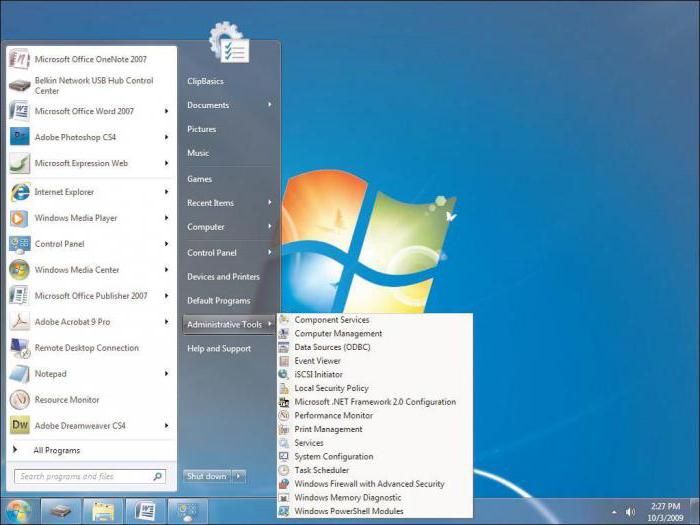
The most common method is to use the Start menu and then select either utilities or administration tools, where the desired partition is located (the difference in location is due to different versions the "operating system" itself).
The second and third methods are also simple. But many users either forget about them, or simply don’t know. You can use the Run menu (Win + R), where the msinfo32 command is written. You can go the other way, first by calling command line(Win + R + cmd) and then entering system info. In principle, how exactly this program will be called does not play a special role. Whom it is more convenient.
Main components of the menu
Now let's look at what interesting things can be found in the "System Information" section. Several main categories are presented here. We immediately pay attention to the line of general information. It contains not only information about the Windows system, but also many parameters associated with it. For example, version, build, disk location, bootloader, etc. You can also view the current versions of installed BIOS and SMBIOS, user and geolocation data, information on "RAM" and virtual memory, or even the state of the Hyper-V module, if there is one. Next up is the hardware resources section. The average user is unlikely to understand what kind of data it is. But the system administrator can easily view some important characteristics to eliminate this or that failure at the hardware level.
The component section is very interesting. It somewhat resembles the "Device Manager", but the data presented in it is more detailed. After all, here you can see not only the name of the component, but information about the driver files. In addition, for multimedia, all codecs and decoders installed in the system are indicated, for network devices- their advanced parameters, for disk drives and controllers - their information, etc. In general, you can learn much more from such information than from the one presented in the manager. We should also pay special attention to devices with conflicts (malfunctions). The Windows OS itself cannot always present such information even in the dispatcher, but here you can get the maximum for each faulty component.
Finally, in the section software environment you can find all the data of interest to the user about drivers, modules, installed and automatically loaded applications and services. And even error information. In outdated "operating systems" you can find more sections of the browser settings - everything related to the Internet or installed Office components. In general, as they say, there is enough information. But few people know that in the environment of this program, you can view the parameters of remote computer terminals or save information about the system in a single text file with the .nfo extension (the program can also work with the .cab or .xml formats).
Third-party utilities for viewing system information
Among the third-party utilities, the most popular programs can be noted. This, for example, PC Wizard from the CPUID developer, familiar to many from the CPU-Z utility, or small applications like SIW, System Spec, FreeSysInfo, etc.

Often they have interesting functions related to setting up or testing equipment, which makes them very popular in their field.
Conclusion
In general, it can be noted that information about the system is not particularly useful for most users in their work. But for system administrators, developers of compatible software, or simply specialists involved in manual assembly or repair, such data will be extremely important. Although some users may also find them useful. For example, in a situation when it is required to make a manual one and the user does not know where to look for it.
Asking how to find out system requirements his computer, the user wants to know the properties of the PC or, in other words, the characteristics of the computer. This is the technical data of the installed devices, on the indicators of which the performance and capabilities of the machine depend. Games and programs are evolving, becoming more demanding, so it is important to upgrade on time.
Having recognized weak equipment that is outdated over time, you can easily replace it. New and more powerful. As a result, you can comfortably use your computer. Knowing the performance and capabilities of your computer, you can easily choose toys that will easily run on it and will work at high settings. Or a program that will work effortlessly and without glitches and brakes.
The main technical indicators that you need to know:
- How many cores and processor frequency
- RAM size
- What video card and its power
- Bit depth windows
- The size hard disk
These requirements are quite enough for the choice of games and certain software. For a more thorough assessment of system performance, additional data is needed:
- hard disk model;
- the frequency of the RAM cards;
- BIOS version;
- resolution, screen frequency;
- DirectX version.
To get the information of interest, you use:
- hardware data collection program;
- internal commands, diagnostic tools;
- built-in operating system templates.
The last method is simple and convenient, does not require programming skills or professional knowledge PC. And so let's get started.
The minimum configuration data can be obtained by going to the system properties. To do this, click right click mouse on "My Computer" then "Properties", in front of you is a window with data.
In which you will see which processor, how much RAM, the version of the windows operating system and its bit depth. And if you made an assessment of performance according to the operating system, then the assessment of performance accordingly.
As you can see, the information is not complete, there is no information on the installed video card. You can view the name of the video card in the device manager or using the 2nd method.
Method 2. How can I find out the PC settings using DirectX?
For correct work programs in the Windows operating system require DirectX installation. This product performs its own system diagnostics, which we will now use and learn more detailed information.
Click on start menu — "Run"(you can just type in the search bar), enter the command dxdiag and press OK.

In the opened tab "System" the main characteristics are indicated, those that we saw in the first method, the name of the operating system, the processor, the amount of RAM, the capacity of the system, etc.
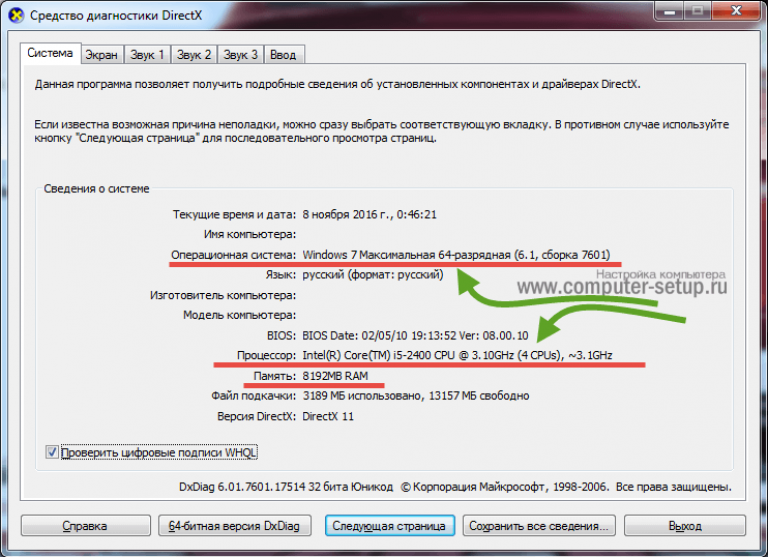
We need video card data, for this we need go to the "Screen" tab in which we see the manufacturer and model of the video card.
![]()
By the way, do not pay attention to the line "Total memory", the data does not refer to the video card. Where the data comes from is not clear to anyone 🙂
Method 3. Information about the system using windows
A fairly simple way to find out the characteristics of your computer. Its meaning lies in a complete analysis of the windows operating system, the characteristics of the pc. And, accordingly, their provision.
In order to use this method, you need to choose how it will be easier for you to launch it, since this utility has 2 launch paths.
First: On the menu "Start" — "All programs" — "Standard" — "Service" and run System information.

Second: On the menu "Start" in the search bar write "System Information" and at the top you will see the result that you will need to run. Launch, and in front of you is a window with the characteristics of the computer.

For what need to pay attention: OS name, Processor (clock speed and how many cores it has), and the amount of random access memory (RAM).

In order to see the parameters and characteristics of the video card that is installed on the computer, you need to go to the "Components" tab and select the "Display" item, here is important information for us: Adapter name and adapter RAM (how much memory is on board the video card)
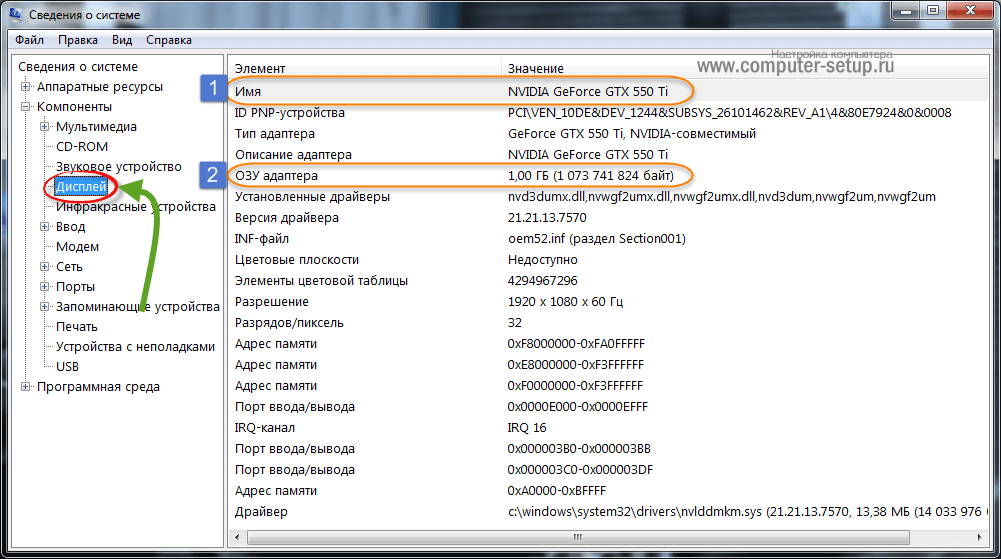
How to find out the characteristics of your computer in windows 8, 10
For Windows 8 and Windows 10, there is another opportunity to find out the data, through the sidebar go to the tab "Options", and select "PC Settings", then "Computers and Devices".

The window that opens contains detailed information about all the key components of the machine.
How to find the parameters of Apple products
In the case of Apple, you will have to use the site http://www.appleserialnumberinfo.com/. Enter serial number PC (listed in the About This Mac tab) in the search bar. In a few seconds, get a detailed report on the system and recommended upgrades.
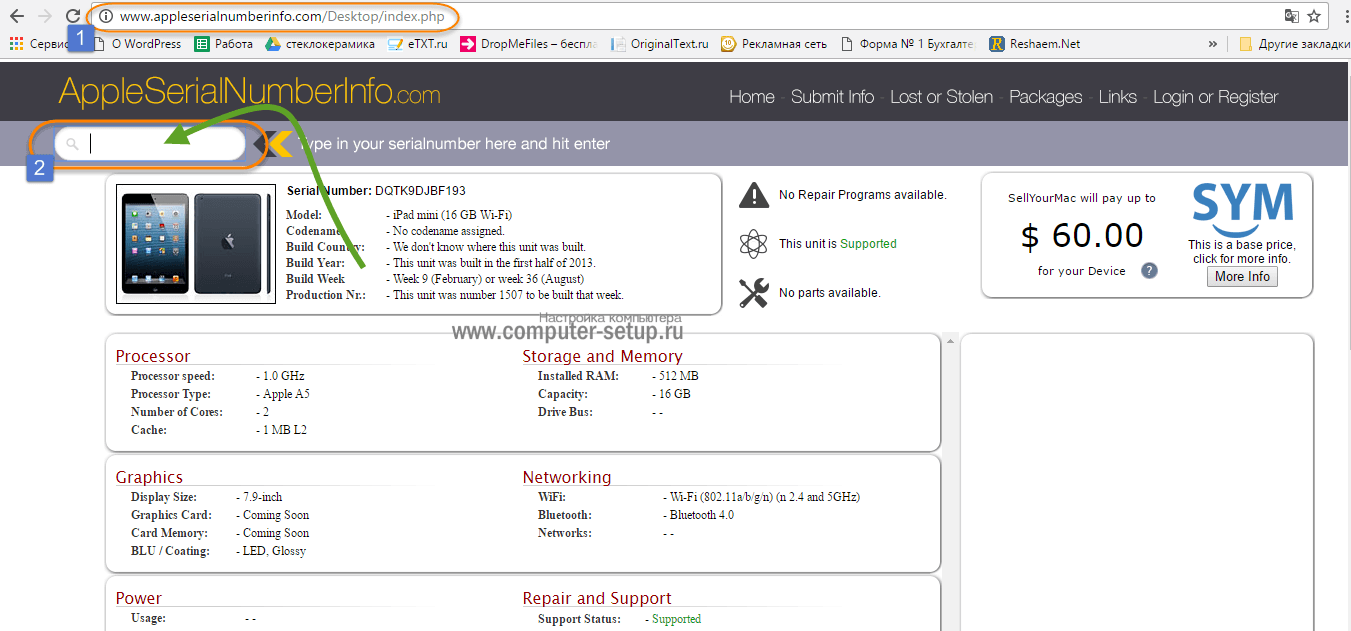
This is the easiest, most reliable way to get information about the characteristics of Apple products.
How to determine the characteristics of a computer using programs?
The options considered are imperfect - they show static information about the system, which is taken from technical characteristics devices and irregular hardware checks. Analyzer programs have been created to correct this shortcoming.
- Perform deep system diagnostics;
- Trace the dynamics of the current state of the PC.
The results will show the characteristics of the main units, load, machine reserves. Based on the results, a decision is made on the need for modernization. If the load is not critical, the scan will reveal temporary files, unnecessary applications, and other garbage. Removing all that is superfluous will free up new resources and make the machine more productive.
Most simple programs no requirements for knowledge of "hardware":
- SiSoftware Sandra;
- Everest;
- ASTRA32.
All three products are free, installed via the .exe file. After diagnosis, they provide a detailed list hardware and basic characteristics of devices.
If you need more information, you can help:
- PC Wizard – free distribution, gives complete information about installed equipment, software, PC power supply, current system load;
- CPU-Z – free distribution, provides data about all installed devices;
- AIDA64 Extreme- the most powerful and functional program PC analysis, but has one drawback - Paid.
AIDA64 developers offer a 30-day trial for the user to evaluate the platform's capabilities. If you need a one-time, but deep diagnostics, this option will be optimal.
Advanced users can get information about the PC directly through the BIOS, but this requires the appropriate firmware. The DOS environment also provides commands to run diagnostics of the hardware state of the machine.
It is better for beginners not to use these methods, in order to avoid possible problems that will arise as a result of careless behavior. For example, a DOS command error will cause a restart and all unsaved data will be lost, and during a hard reboot, a voltage surge will occur, which will lead to a short circuit and damage to the hardware.
P.S. We have considered the main, most available ways how to find out the system requirements of your computer. If you need more complete information on your computer, you can use the special software described above. But I assure you that the data that you get by the methods described above is quite enough for choosing games or showing off among your friends.
P.P.S... If you have any difficulties, or comments on the methods of obtaining PC performance data. Or if you want to thank, write in the comments. I will be glad.
In contact with
If you are a user who wants to learn how to work at a computer independently, then you should know how to find out the characteristics of your computer using standard Windows tools, as well as use programs that show detailed information about the hardware installed in the computer.
More detailed information about the devices that are on the computer, you cannot look through standard means. But in 90% of this information is enough for the task at hand.
Without installing programs
If you do not have a special program at hand, then you can use the standard Windows tools... To do this, right-click on "Computer" and click on "Control" in the drop-down menu.
The "Computer Management" window will open, on the left, click "Device Manager". After that, the devices that are in your computer will appear on the right side of the window.
How to view the characteristics of a computer, you will also be helped by the standard utility, which shows part of the information about the devices. To do this, go to "Start" - "All Programs" - "Standard" - "Service" - "System Information".
You can also use dxdiag. To do this, go to "Start" - "Run" or the keyboard shortcut Win + R and enter dxdiag. After that, when entered, press Enter.
The DirectX Diagnostic Tool window opens. In this window, you will see: computer model, computer manufacturer, Bios version, processor parameters and memory.
If you go to the "Monitor" tab, you can see the type of microcircuits and the manufacturer of the video card.
I think you have already noticed that these utilities do not show more detailed information. Due to the fact that Windows does not have more detailed information about the installed devices, various programs have been created that show detailed information about the devices on the computer. Of these programs, there are paid and free ones, we will consider one of free software which displays technical information about devices.
The information above applies not only to how to find out the characteristics of your computer in Windows 7, but also for other systems.
Free CPU-Z program
The program is called CPU - Z, with the help of it you can find out the following parameters:
- Processor;
- Motherboard;
- Random access memory;
- Video cards;
- Other.
I also want to note this program does not require installation, making it easy for the user to use.
Introduction
What are all these utilities for displaying information about the system for? Each more or less advanced user will tell you in detail about the configuration of his computer. But what about nontrivial things like drive mode (is DMA enabled)? Or frequency system bus(does it make sense to buy faster memory - does the processor work for more high frequencies system bus)? In addition, a very common situation is when you remotely consult your more knowledgeable friend (for example, about the same upgrade), and he asks you to specify the exact chipset and revision of your motherboard.
In all of the above cases, utilities that display detailed information about the system can help significantly. You may ask - what's wrong with the regular "Device Manager" included with Windows?
Basically, it can provide answers to many questions regarding the configuration of your system. But the utilities considered today appear for a reason - the user needs a convenient interface, a centralized supply of information (which is desirable to obtain in an accessible form), as well as "tasty" additional plugins (for example, tests for processor and RAM performance). In all honesty, do you know offhand where all the variety of data about the system is stored (after all, they are scattered in different corners of it)? And in utilities - "everything in one bottle" ... In general, in the auto industry there is such a thing as "tuning" - people turn to a car-studio to improve convenience and additional features... In principle, some parallels can be drawn with our case.
The criterion for the subjective assessment of today's test subjects: free delivery (the absence of adware and spyware was the main condition for getting into the list), stable work. Well, if the interface is also convenient, and additional modules or plugins are available, then you cannot do without the recommendations of such a program for installation on your computer. And one more important point - we will test under the Windows Vista operating system - we will check the readiness of all applicants for professional suitability in the environment of the new operating system from Microsoft.
I will make a reservation right away - I will not meticulously describe all the capabilities of the utilities, but will focus on conveying my own impressions of getting to know their functionality (in addition, screenshots will tell much more). If you are interested, then detailed specifications and reference documentation are always available on the project sites, the addresses of which are given at the beginning of each of the descriptions.
Program website: http://www.cpuid.com/pcwizard.php
Developer: CPUID
The author of the PC Wizard program is familiar to many of us from his famous CPU-Z utility. Both products have been developed for over 10 years, and there is no reason to doubt the author's professionalism.
The distribution kit of the program takes about two and a half megabytes in the archive (there is also a version with an installation module). In the case of an archive, after unpacking the program is immediately ready to work (it's nice that it is localized into Russian), a few seconds after analyzing the system and polling the sensors - you can go to study the details.
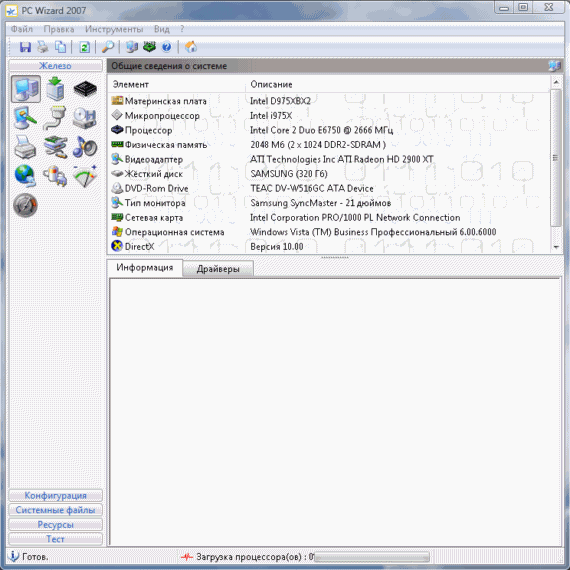
The program interface has five sections: "Hardware", "Configuration", "System Files", "Resources" and "Test".
"Iron"... Information is given (mostly comprehensive) about all system components, be it the motherboard, processor or RAM modules. Take, for example, a processor - you will learn not only its characteristics, but also the current temperature, core voltage, load level, etc. What more could you ask for?
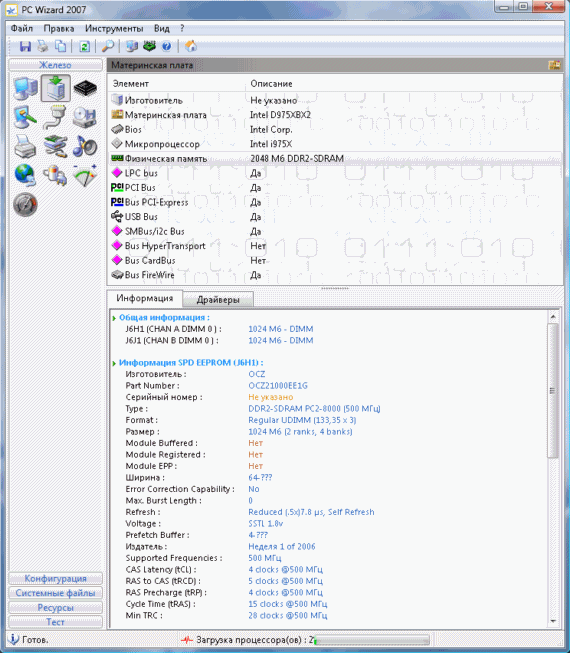
At the bottom of the window there are two tabs "Information" and "Drivers". In the first - it is given detailed description specifications, parameters and their values, etc. In the second, information about the drivers is given. Not everything is perfect here - for a number of components PC Wizard was unable to determine the driver data (for example, I did not display information about the printer drivers, USB controller, and even the ATI Radeon 2900XT video card). There are minor translation flaws - for example, the item "Drivers" in "Hardware" was more correctly designated as "Drives". In addition, a number of section titles were left without translation.
The Voltage, Temperature and Fans section deserves special attention - it summarizes the information received from various system sensors.
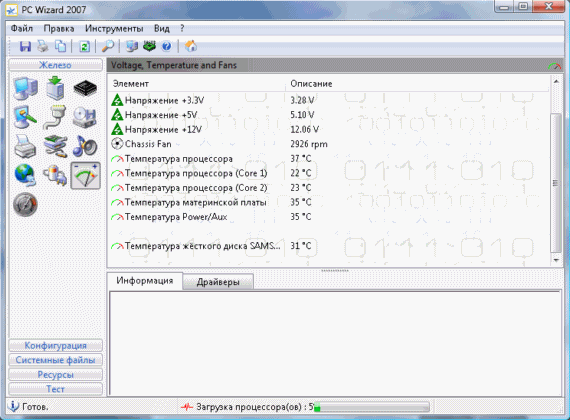
"Configuration"... It contains information about the operating system (version, serial number, user, etc.), web browser, control panel, desktop, processes and threads, dynamic libraries (with decryption), OLE records, software products Microsoft, installed TrueType fonts, updates (for some reason this item was empty for me, apparently it only displays information about the Service Pack). There is also a section installed programs, information about startup applications, file type associations with applications, DirectX components, security information, media components, performance statistics, etc.
This section is a little "damp" - in some places there is no data, somewhere there are flaws (I displayed "winter" time, and in the decoding in the Information panel, the correct, summer time was indicated). In general, the author still has something to polish.
"System files"... This section centrally displays the information contained in system files Boot.ini, System.ini, Win.ini, etc.
"Resources"... List of busy interrupts, channels direct access to memory, input / output ports, memory resources. Some points did not work for me - an empty form was issued.
"Test"... This section contains a number of tests for your system so that you can evaluate its performance. You will be able to evaluate the overall performance with the ability to save the results (and comparison after the upgrade).
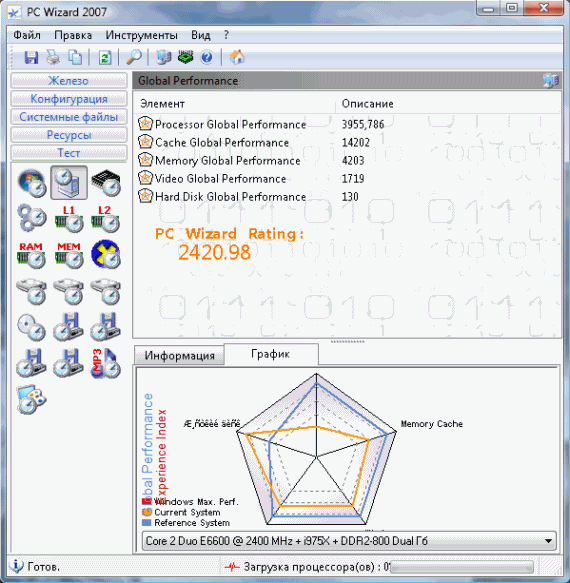
Most of the tests are synthetic, there are variations in the results. If you wish, you can compare your results with the data stored in the PC Wizard database. This can be useful for identifying cases where your system is not optimized properly. I liked it very much next moment- when comparing your results with benchmarks from the database - you use the slider to adjust the transparency of the window and then overlay it on the results graph to visually compare the chart bars.
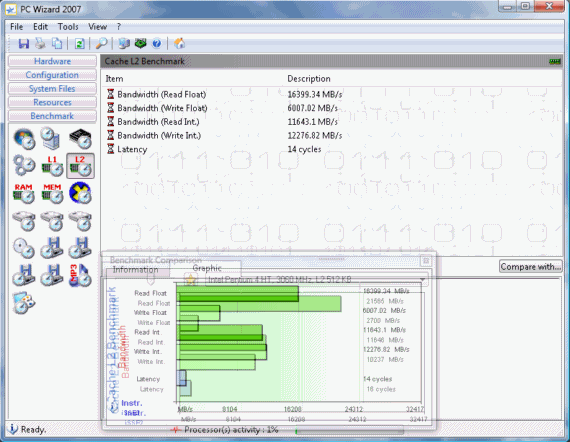
The set includes tests of the speed of reading and writing to the cache of the first and second levels of the processor, the speed of the hard disk and optical drive, RAM. There is even a test of a video card for 3D performance, but it is completely primitive. I would also mention the MP3 compression test, but you need an audio CD for it.
Summary: impressions from PC Wizard 2007 are very positive. It looks like a large beautiful house with many rooms, although a few are not yet finished, but what is there is impressive. Unfortunately, there are some flaws in the localization into Russian.
SIW (System Information for Windows)
Program website: http://www.gtopala.com/
Developer: Gabriel Topala
Romanian programmer Gabriel Topala presents to our court the SIW utility (an abbreviation for System Information for Windows). The utility interface will display the following screenshot:

On the left, there is a tree structure of the components for which information is displayed. The "roots" of the tree are the Software, Hardware and Network sections. In addition, there is also a Tools menu, which contains useful additions. So, first things first ...
Software... Information about the operating system (kernel version, serial number, time since the last boot, etc.); updates ("patches" from Microsoft); list of programs (names, exact versions, installation date); applications - system and other (name and size of the file to be launched, vendor, directory path, creation date, attributes, etc.); licenses (list of serial numbers detected licensed programs); regional settings; file associations with applications; list of running applications; list of loaded dynamic libraries; list of file system drivers and kernel-level drivers; list of programs loaded with Windows; list of installed multimedia codecs; list of ActiveX components; list open files(with the names of applications and processes that opened them); a list of passwords from autocomplete, etc.
In addition to standard information components, I will note here such useful things as the displayed serial numbers of licensed applications and a list of passwords from autocomplete forms - for especially forgetful users, of course (and not for malicious purposes).
Hardware... System information (Windows Vista performance index, disk space, physical RAM and its load, virtual memory, paging file size, registry size, etc.); motherboard (manufacturer, model, version, serial number, chipset, devices on the board, memory slots, etc.); sensors (information about the temperature of the processor cores and the temperature of the hard drive); BIOS (version, release date, developer, size and specifications); information about the processor (name, code name, technical process, platform, frequency, multiplier, cache, instructions, etc.); devices (in principle, this section practically gives information from the Manager Windows devices which is even structured similarly); PCI (information about devices using this bus); system slots; network adapters(name, manufacturer, speed, MAC address, parameters of the established connection); memory (information about installed memory modules - type, frequency, size, baud rate, error correction, etc.); video (information on video card, monitor, supported resolutions, DirectX version); drives (comprehensive information on hard drives, optical drives, removable USB drives, etc.); logical drives(common space, free space, type of file system, device type, bus, etc.); ports (serial and parallel, USB, modem); battery (in the case of a laptop); printers (printers installed on the system, name, attributes, capabilities, port connection, etc.).
In my case, the information from the sensors is not as complete as we would like - for example, the processor temperature was absent (instead of it, the temperature of each of the two cores was indicated separately, and for some reason it turned out to be five degrees below room temperature), and the cooler speed was also absent processor. I also note a minus in displaying information on a video card - it is issued in a raw, unformatted (for better readability) form. Incidentally, this is not an isolated case.
Network... Network information (computer name, name working group, socket version, IP address, DNS servers, etc. - similar to the information given by the "ipconfig / all" command); additional information (external IP, country, longitude and latitude of the location, Internet service provider, running servers, information on NetBIOS, etc.); Search network environment; open ports (protocol, application, state, local and remote address, description); general access (local resources "shared" by you); remote connections, network (search network resources local network).
I liked this section, especially " Additional Information", for which, by the way, you need to connect to external network resources.
Useful tools
SIW comes with several useful utilities, some of which we will discuss in this section.
Change of MAC-address.

Actually, it allows you to change the MAC address. Use with caution - if your ISP authorization is tied, among other things, to the MAC address, you will run into problems.
Eureka!
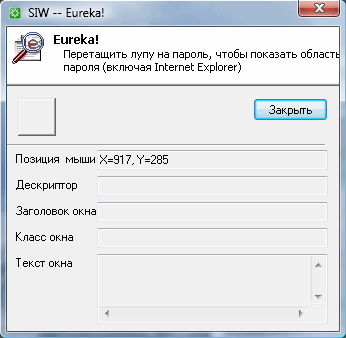
This module allows you to display the password hidden behind the "asterisks" - for example, in the account field with auto-complete password or in the mail client. In my case (Windows Vista), the module could not figure out either the password behind the asterisks in the mail client, or the password in the autocomplete form Internet Explorer- apparently, Eureka! works maximum under Windows XP.
Cracking password... This module allows you to extract information from .PWL files for Windows 9x operating systems.
Network traffic.
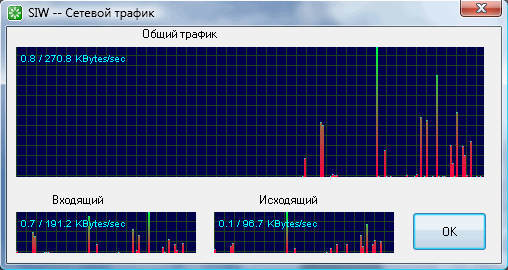
A simple module that displays a graph of the activity of a network connection. It is useful for determining real speed access or tracking suspicious network activity.
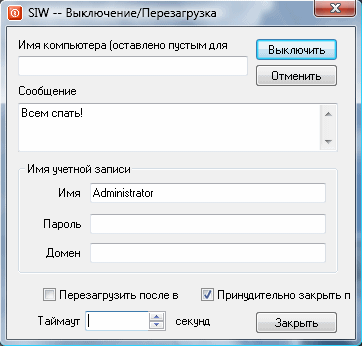
Allows you to turn off or restart the computer (with forced closing of applications) after a certain amount of time (in seconds). It can be useful for limiting the time of work at the computer of other users (primarily children) - provided, of course, that you have a password set in the BIOS.
Summary: Not a bad utility, deserves a solid four, but a number of areas need work. It is interesting, first of all, by the additional instruments included in the composition.
Program website: http://www.alexnolan.net/software/sysspec.htm
Developer: Alex Nolan
The application is one and only executable file, and this immediately wins my sympathy. How will it be further? And then - at launch, an interface of this kind opens in front of us:
![]()
This information window is basic and always returns to the interface display. You get access to the components both from the graphical toolbar and from the drop-down text menus. In the case of the graphical panel, some buttons have access to additional functions - through the drop-down icons when you click on the black arrows on the right.
Let's go through the presented "information buttons". Each window displayed by clicking on them, by the way, has items for updating information and printing it, which can be convenient in some cases.
Personal... Computer owner; operating system build number; system uptime since the last boot; default printer; the serial number of the operating system license; .NET Framework libraries version; etc.
I must say that some fields were not filled in for me - for example, the serial number of the hard disk, the original installation path, etc.
Memory... The physical amount of RAM and the available (free) amount; the size of the paging file and its available space; virtual memory sizes; channel width; frequency, etc.
Display... Display Information - adapter name, chipset, onboard RAM, graphics resolution, font information.
For some reason, the utility did not recognize my ATI Radeon 2900XT video card in this module.
Drive... Disk name; file system type; volume serial number; size and free space; the number of bytes in the sector and the number of sectors in the cluster; the total number of clusters and the number of free clusters; system "flags"; information from S.M.A.R.T.-area.
There is also a CD / DVD Information menu item - displays information about the optical drive (manufacturer; model; firmware version; description; drive letter; status; list of possibilities for reading and writing).
Cpu... Processor name; family; manufacturer; serial number; frequency; voltage; L2 cache size; capabilities and command sets, etc.
I could not determine the frequency at which the second-level cache works. The CPU button when "expanding" gives one more option - displaying a small window with a graph of the CPU resource utilization.
Internet... Internet connection status; start page in Internet Explorer; default directory for saving files; list of recently visited sites; some flags in browser settings.
A bit of a messy section, in which I have not determined the installed search bar from Google under Search Bar.
Programs... A list of installed programs is displayed, slightly more extensive than the Add / Remove Programs window in Windows XP (or Programs and Features in Windows Vista). Program name, version, manufacturer's website, phone number technical support, installation location on disk, installation source, vendor, path to Readme files, path to uninstaller file, etc. Separately, I would like to note the ability to quickly go to the website of the application manufacturer using the Website button and the colorful Delete Entry button, which allows you to delete an unnecessary entry from the displayed list of installed programs (it is useful in case of failures that leave information about the program after its complete removal).
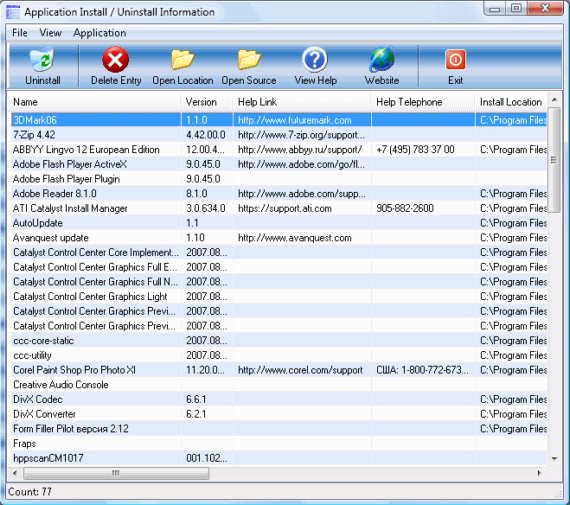

A simple user will be scared, but hard-core system administrators will feel like a fish in water. The utility displays information in the following categories: NDIS Info, System Info, System Accounts, User Accounts, Share Info, Network Connections, Network Adapters, Adapters Configuration, System Processes, Computer System, Display Info, System Settings, System Services, System Devices, Logical Disks, Serial Info, Proxy Settings.
In general, despite the output of information in a raw form, you can still find its advantages - the information output (in particular, useful information about certain settings of the operating system or device drivers) is very interesting. My utility could not give information about network connections(most likely due to incomplete compatibility with Windows Vista).
Summary: Still, it is obvious that FreeSysInfo is a "piece" that is part of complex network audit packages. Here we see a minimum of friendliness towards the end user and the issuance of raw information. The previous subjects had the necessary data - they were immediately in sight, here you have to rummage through the displayed list with technical information and find the information you need, moreover "raw" (for example, in the "country" field you will see not Russia, but "code 7", search for yourself by the code, etc.). In general, the target audience of the project is advanced users and system administrators.
Program website: http://www.xtort.net/xtort-software/xpsyspad/
Developer: Kenny Heimbuch (xtort.net)
The distribution is a little less than 800 KB and requires installation after downloading. We reviewed version 7.9 of the XP Syspad utility. After installation, the following window appears in front of us, in fact, copying the task manager window with information about the running processes:
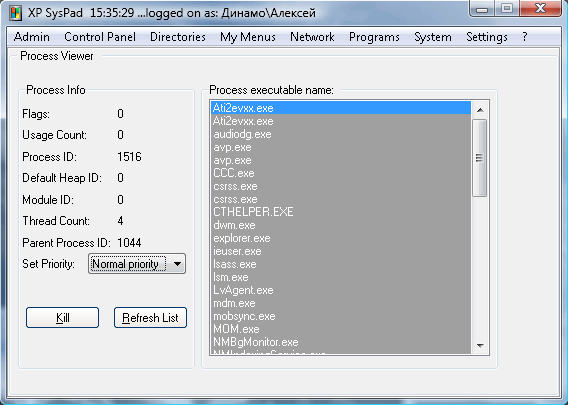
Further, navigation is carried out by the titles of the lists of menu commands: Admin, Control Panel, Directories, My Menus, Network, Programs, System, Settings, Help.
I will not list all the contents of these categories, I will just say that again we are faced with a situation where the developer did not begin to invent a bicycle, but decided to simply place links to many components, information modules and configuration tools of the Windows operating system within the interface of one utility. It is important that the XP Syspad is "minimized" in the System Tray and is available from there at any second.
You can launch regional settings, view user accounts, delve into the Control Panel items, quickly switch to usually difficult to access (read - in a few mouse clicks with a careful peering at a large list of folders) directories and menu items, clear the web browser cache, view the address e-mail client book, find out the IP address, call the calculator, open / close the CD-ROM or DVD-ROM drive tray, copy floppy disks, display a list installed drivers, etc. This is just the tip of the iceberg - in total, the utility provides centralized access to about two hundred standard functions of the operating system.
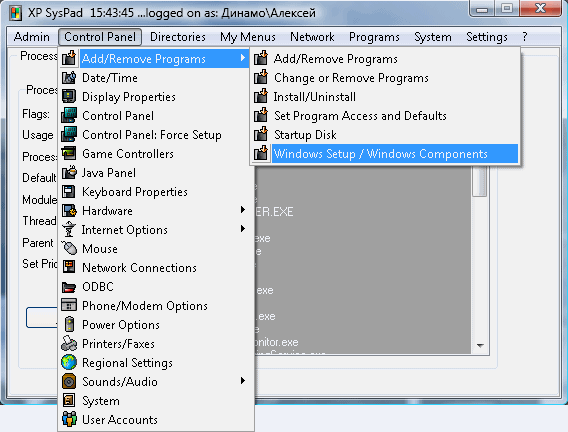
There are also some nice little additions - like the ability to display the IP address, serial number of Windows and Office, etc.
Unfortunately, information about the hardware of the system is not encouraging - for example, what the data about the processor looks like:
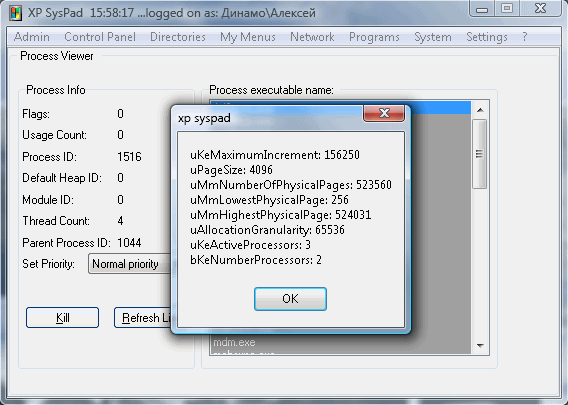
Not too friendly and informative, right? Some of the menu items do not work (some incompatibility with Windows Vista is obvious, when working under which my XP Syspad noticeably "slowed down"), so if I recommend this product, then first of all - Windows users XP, which, in fact, warns about the very name of the utility.
Summary: XP Syspad provides centralized access to components, information modules and settings of the Windows operating system by "sitting" with an icon in the system tray. Full-fledged and comprehensive information about hardware components is not issued. XP Syspad is, rather, a configuration tool with the ability to display some amount of information about the system.
Conclusion
I am sure that many readers can add a couple of other utilities to the list of presented utilities (and some enthusiasts can add a couple of dozen in general). There are a lot of offers of this kind on the Internet. I chose these five programs simply because they caught my attention at different times and were postponed for further study.
Without a doubt, my favorite was PC Wizard 2007, and the professional level of the creator of this program evokes extremely respectful responses. Yes, something needs to be done, "combed", finalized, but all this mainly concerns minor things.
System Information for Windows is also very good, although it is obvious that PC Wizard 2007 looks more interesting. On the other hand, SIW contains additional useful components (in PC Wizard 2007, additional tests are mainly interesting), such as changing the MAC address, timer for turning off the computer, etc.
The rest of the participants are either specific, or mediocre, or slightly off-topic applications, which I cannot recommend to all users without exception.
ADDITIONAL LIST OF USEFUL UTILITIES
This article, I hope, will have a long "life". In this last section, specially highlighted in capital letters, I will indicate utilities that are similar in functionality to the current participants in the scrutiny.
Send applicants or to my address Email, or talk about them in our conference.
I will also try to supplement this article with fresh samples I find. So let's start, perhaps ...
Lansweeper
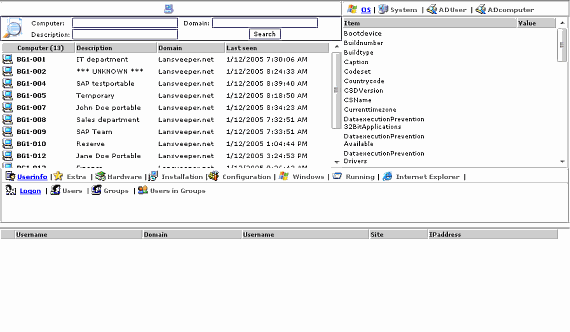
Program website: http://www.lansweeper.com/
Developer: Geert Moernaut
Very often, users of operating systems of the Windows family ask the question - how to find out the characteristics of their computer. Since the question is quite popular, we decided to describe the process of obtaining information about a PC on all popular Windows versions.
After reading the material, you will understand how you can easily get all the information about the characteristics of a laptop or stationary PC, be it Windows XP, 7, 8 or Windows 10.
Obtaining information on the technical characteristics of a PC using standard Windows tools
Most in a simple way to obtain the characteristics of a computer is to use the command " msinfo32" in a programme " Execute». This function launches the utility MSinfo32 which describes the detailed configuration of your computer. MSinfo32 can be used starting from versions Windows NT... That is, you can run it on both Windows XP and the latest Windows 10 operating system without any problems.
Let's try to run the utility on a computer running Windows XP. To do this, run the program " Execute"Using the Win + R key combinations and enter the command" msinfo32».
Now press the Enter key to run the utility MSinfo32.
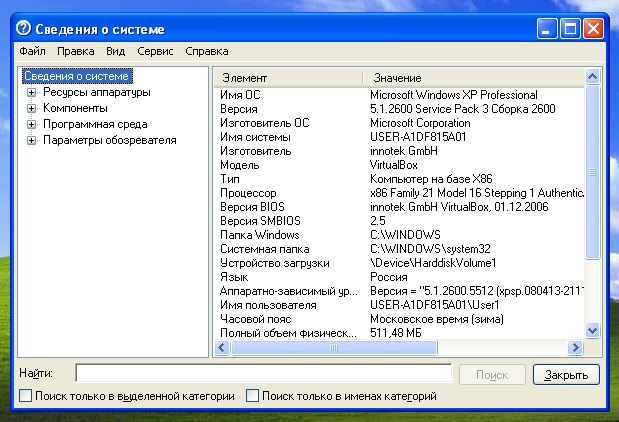
In the program window you can find out about all the hardware and software parameters of your PC. Launching the utility on Windows 7, 8, 10 is similar to launching it on XP. Although the launch of the utility has remained the same, the design of the utility has undergone minor improvements. It looks like MSinfo32 in the seven:

In Windows 8 and 10, the interface is almost unchanged. This is what the utility looks like in Windows 8:
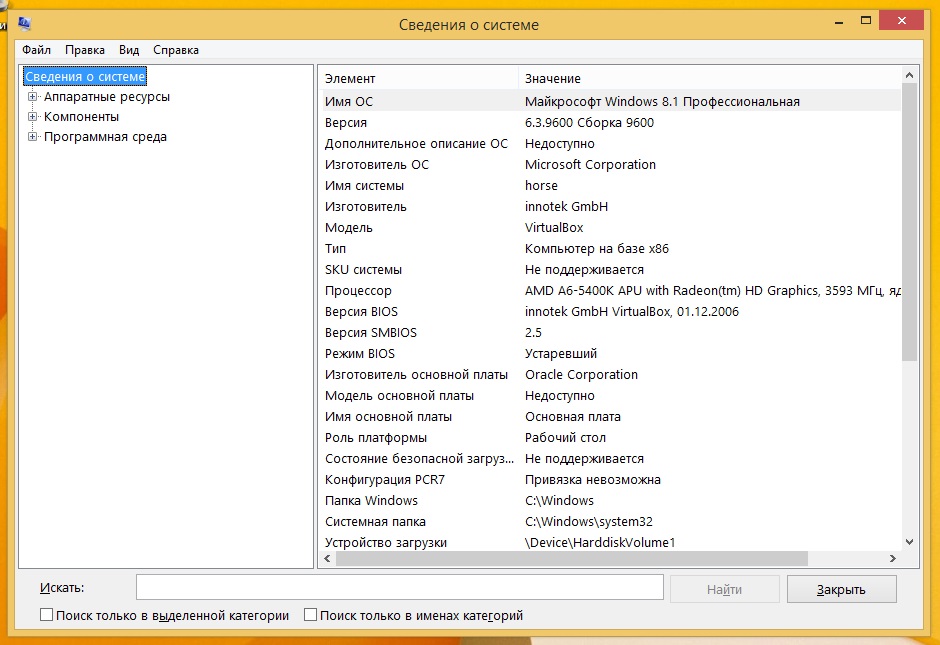
And in the top ten like this:

As you can see, using the program MSinfo32 you can see all the information about the hardware and software parameters of your laptop or desktop computer on almost all versions of Windows... Another utility MSinfo32 can be found in the menu " Start"And in" Control panels"And run from the shortcut" System information».
Another interesting way to determine the parameters of a computer is the systeminfo command in the console. This command is especially popular among system administrators because it allows you to quickly find out all the information and copy it. " Systeminfo"Also works on most versions of Windows, which is a big plus. To use the command in Windows XP, you must start the console. The console is launched in the program " Execute"By the command" CMD».

In the running console, enter the command “ systeminfo", After which all information about the characteristics of a laptop or stationary PC will be displayed in the window.
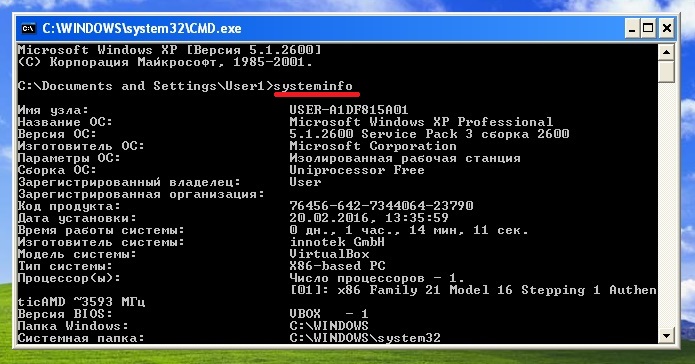
As mentioned above, the launch of this command can be carried out on almost all versions of Windows. Startup in Windows 10 is shown in the figure below.

It makes no sense to show the execution of the command in the seven and eight, since it is almost identical to the image for Windows 10.
Viewing system information using Speccy
Utility Speccy can be downloaded from its official website www.piriform.com. Installing the utility will not cause problems even for beginners. The figure below shows a window with a running Speccy.

With the help of Speccy you can get detailed information about all the components of your computer. For example, you can see the state S.M.A.R.T hard drive. In addition to hardware and software parameters of the PC, Speccy is able to display information about CPU temperature, chipset motherboard, hard drive and video card. The utility takes this information from the BIOS. The utility also provides a convenient copying and storing information... If you go to the file menu:
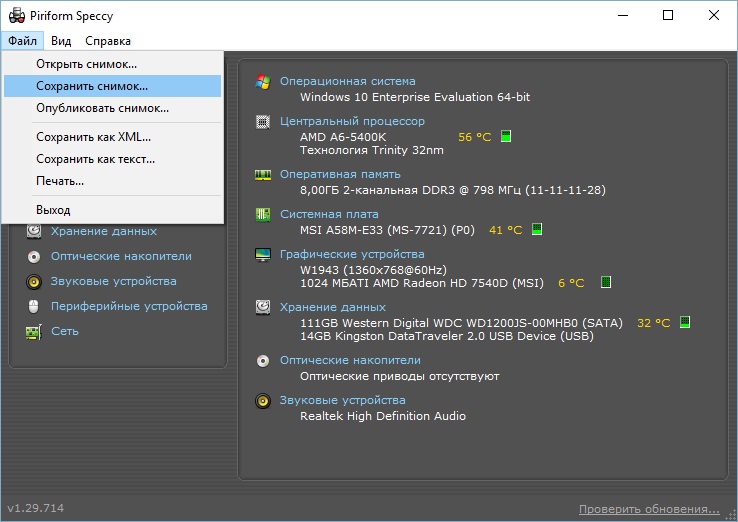
then you will see that the utility is able to save and open snapshots with information about the analyzed PCs. Such a snapshot can be opened and checked in Speccy on any laptop or desktop computer... Besides, Speccy knows how to save data in text formats"XML" and "TXT".
As you can see, a rather interesting and functional utility and, moreover, absolutely free. Speccy works on all Windows, starting with Windows XP and on all current server operating systems.
Obtaining technical characteristics using CPU-Z and HWMonitor
There are two programs included in this chapter CPU-Z and from the CPUID developer. CPU-Z shows detailed characteristics of computer components, and with the help you can find out indicators such as cpu temperature, chipset motherboard, hard drive and video card. In addition, from you can find out information about fan speed and indicators stresses PC components.
Download CPU-Z and can be found on the official website www.cpuid.com. Utility CPU-Z opens in the first tab “ Cpu". This tab shows all information about the processor.
![]()
The second tab " Caches"Shows data about the processor's cache.

In the third tab “ Mainboard»You can find out everything about motherboard in the PC.
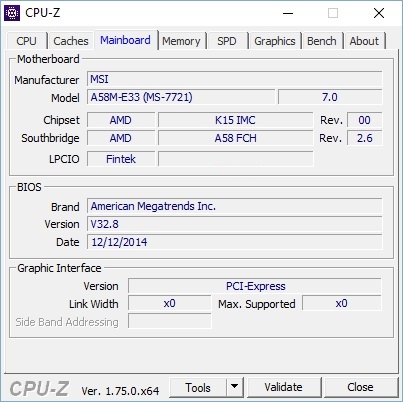
The fourth tab " Memory"And the fifth" SPD»Give information about your RAM.

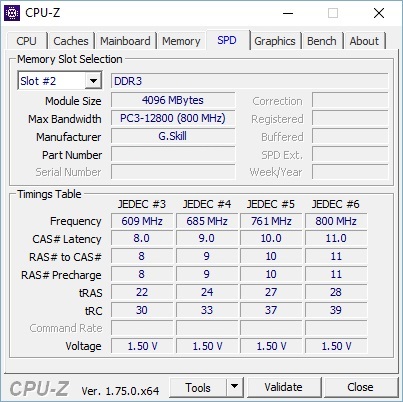
The sixth tab " Graphics»Shows information about your video card.
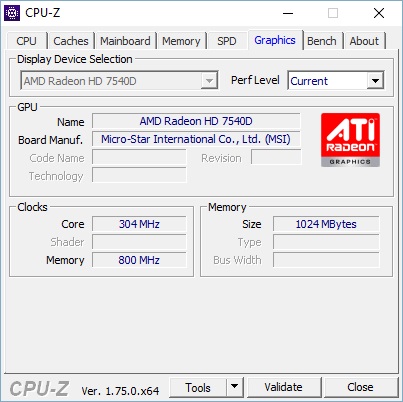
V CPU-Z organized convenient storage of all information in text files"TXT" and "HTML". To save them, just click on the list in the lower area of the program and select the appropriate item.

The main purpose is monitoring data on temperature, voltage and speed of coolers... Once opened, the user will immediately receive all monitoring data.

As you can see CPU-Z and together provide the user with a powerful tool to extract information about the properties of their computer. Besides CPU-Z and work on all popular versions of Windows, starting with XP and ending with a dozen.
Viewing graphics card details with GPU-Z
GPU-Z is a fairly popular utility for obtaining complete information about the properties of your video card. Its creator is the well-known Internet portal www.techpowerup.com. Download GPU-Z can be on the same portal.
The utility is somewhat similar to CPU-Z, but its main purpose is to illuminate all information about the video adapter. Having opened the utility, you will immediately get all the information about the video card on the first tab. In our case, the video adapter is considered AMD Radeon HD 7540D.
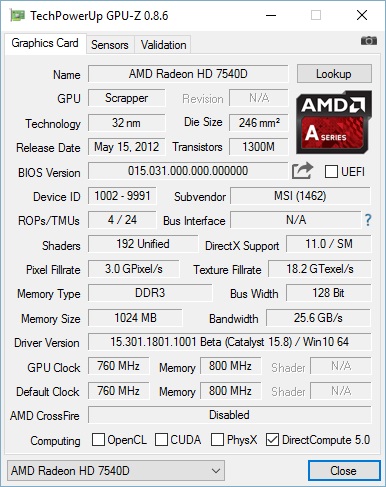
On the second tab “ Sensors»The user can get information about the frequency, temperature and voltage of the video adapter.
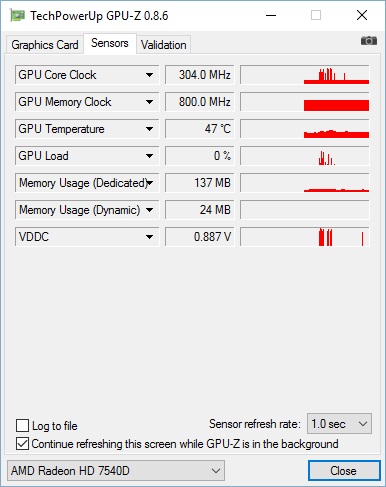
In addition to receiving information, GPU-Z knows how to keep Graphics adapter BIOS and take screenshots of your working window. GPU-Z can be run on Windows XP, Vista, 7, 8, and 10.
Summing up
The review shows that getting information about the characteristics is quite simple both standard Windows tools and special programs... For the review, we have selected some of the simplest and most popular programs that a novice PC user can handle. In addition to the utilities considered, there are also other well-known programs with which you can find out all the information about the system:
- HWiNFO32;
- AIDA64;
- SiSoftware Sandra Lite;
In our opinion, the best choice is the AIDA64 program, formerly called EVEREST.
All the programs reviewed will be especially useful when replacing old PC components with new ones. Also, if you decide to sell your old PC, then such utilities will be of great service to you, since when making an advertisement for sale you need to indicate all the characteristics of the computer.
We hope that our review will help you find out all the characteristics of your PC on operating Windows systems your PC.
Related Videos
 Odnoklassniki: Registration and profile creation
Odnoklassniki: Registration and profile creation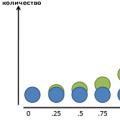 E is. E (functions E). Expressions in terms of trigonometric functions
E is. E (functions E). Expressions in terms of trigonometric functions Social networks of Russia Now in social networks
Social networks of Russia Now in social networks